Constructing Divisia Monetary Aggregates for the Asian Tigers
Abstract
1. Introduction
2. Methodology
2.1. Simple Sum
“There are two objections to Formula 1, the simple arithmetic (1) that it is simple and (2) that is arithmetic; that it is at once freakish and biased.”
2.2. Divisia Index
2.3. Benchmark Rate
2.4. Vector Error-Correction Model (VECM)
2.5. Forecast Error-Variance Decomposition (FEVD)
3. Data
3.1. Hong Kong
3.2. South Korea
3.3. Singapore
3.4. Taiwan
4. Results
4.1. Divisia Monetary Aggregates Results
4.1.1. Hong Kong
4.1.2. South Korea
4.1.3. Singapore
4.1.4. Taiwan
4.2. VECM Results
4.2.1. Hong Kong
4.2.2. South Korea
4.2.3. Singapore
4.2.4. Taiwan
4.3. FEVD Results
4.3.1. Hong Kong
4.3.2. Taiwan
4.4. Forecast Evaluation and Residual Analysis
4.4.1. Hong Kong
4.4.2. Taiwan
5. Conclusions
Author Contributions
Funding
Data Availability Statement
Acknowledgments
Conflicts of Interest
Appendix A
| Authors | Country | Data Sources | Components | Years | Research Design | Main Results |
|---|---|---|---|---|---|---|
| Anderson and Jones (2011) | US | Federal Reserve Board, Bank Rate Monitor Corporation, FRED | M1, M2 | 1967–2011 | Divisia monetary aggregates, Revision of Monetary Services Indexes | Monetary services indexes (MSI) using Divisia monetary aggregation improves the accuracy of economic forecasts compared to simple sum aggregates, especially for broader monetary measures. |
| Barnett et al. (2022b) | China | People’s Bank of China, China Statistical Yearbook, Ant Group IPO prospectus, Alibaba China. | M0, M1, M2, M3 | 2000–2020 | Divisia monetary aggregates, Spectral analysis, Dickey–Fuller Test | Divisia aggregates outperform simple sums, especially for broader aggregates. Augmented Divisia captures COVID-19 effects. All aggregates have low short-run but high long-run coherence with GDP. Monetary aggregates lag GDP in the short run. |
| Barnett et al. (2016) | India | OECD database, Index Mundi, Econ Stats website, (Ramachandran et al. 2010) | M1, M2, M3 | 2000–2008 | SVAR analysis, Impulse response analysis, Variance Decomposition, Flip-Flop analysis, Forecasting | Models with Divisia monetary aggregates outperform those with simple sum aggregates in explaining exchange rate fluctuations and monetary policy impacts. |
| Belongia and Ireland (2022) | Euro Area | ECB, Bruegel | M1, M2, M3 | 2001–2019 | P-star regressions for the price level | Divisia monetary aggregates significantly predict inflation, with larger and statistically significant coefficients when the sample includes the COVID-19 pandemic period. |
| Belongia and Ireland (2021) | UK | Bank of England | Not applicable | 1978–2019 | P-star model, H-P filter | Divisia monetary aggregates provide a more stable framework for nominal income targeting under the zero lower bound. |
| Belongia and Ireland (2016) | US | Center for Financial Stability, Federal Reserve | M1, M2 | 1967–2013 | Structural VAR | Strong correlations between money supply measures and economic output/prices, especially when using Divisia monetary aggregates instead of simple-sum measures, suggest monetary policy plays an important role in business cycles. |
| Benchimol (2016) | Israel | Bank of Israel, Michelson and Suhoy (2014) | M1, M2 | 1995–2013 | New Keynesian DSGE models, Bayesian estimations, Simulations | Divisia monetary aggregates significantly impact output during crises, offer better forecasting accuracy, and money shocks predict financial risks. |
| Berar and Owladi (2013) | UK | Bank of England, Bankstats | Not applicable | 2011–2012 | Description of amendments to Divisia money series calculation | Switching the ISA interest rate in Divisia calculations from quoted to effective rates leads to downward revisions in Divisia money growth series, especially for the household sector. |
| Bhatnagar (2022) | India | Reserve Bank of India, Central Statistics Office | M1, M2, M3 | 1999–2019 | VECM, FEVD | Divisia aggregates with narrow money better predict economic activity compared to simple sum aggregates. |
| Binner and Kelly (2017) | Taiwan | Central Bank of the Republic of China (Taiwan), DataStream | M2 | 1985–2016 | Block recursive structural VAR model | Divisia monetary aggregates resolve short-run price, output, and exchange rate puzzles and provide sensible long-run impulse responses to monetary shocks. |
| Bissoondeeal et al. (2010) | UK | Bank of England Datastream | M1, M2 | 1977–2008 | Cointegration analysis, Maximum likelihood approach of Johansen and Juselius (1990) methods, Weak exogeneity tests, Parameter constancy tests | Long-run money demand relationships exist for UK Divisia and simple sum aggregates, with similar elasticities and minor differences in share price effects. |
| Brill et al. (2021) | Euro Area | ECB Statistical Data Warehouse, MFI | M1, M2 | 2003–2018 | Divisia monetary aggregates, Panel probit analysis | Divisia monetary aggregates for the euro area predict recessions more accurately than simple-sum aggregates and are useful for macroeconomic analysis and forecasting of country-specific monetary conditions. |
| Chen and Nautz (2015) | Germany | Deutsche Bundesbank, ECB, Eurostat, MFI | M3 | 2001–2014 | Divisia monetary aggregates, Structural VAR models, DM-test | The divergence between M3 and Divisia M3 provides superior forecasts for German output growth during the Great Recession compared to models using only M3 or Divisia M3. |
| Darvas (2015) | Euro Area | ECB, Bruegel, Eurostat | M1, M2, M3 | 2001- 2014 | Structural VAR models, Impulse response functions | Divisia monetary aggregates significantly impact output and prices, while simple-sum measures do not show significant results. |
| El-Shagi and Kelly (2013) | Euro area | Eurostat, IMF, ECB, NCB | M3 | 2003–2013 | Divisia monetary aggregates, Signals approach | Divisia aggregates are excellent predictors of debt crises, better capturing liquidity changes than simple sum measures. |
| Fleissig et al. (2023) | Euro Area | ECB | M1, M2, M3 | 2000–2021 | Fourier demand model, VAR models, Impulse response functions | Divisia monetary aggregates are robust to benchmark rates except during the global financial crisis, indicating differences from simple sum aggregates, particularly in elasticity and substitution responses. |
| Ghosh and Bhadury (2018) | India, Israel, Poland, the UK, the US | Bank of England, Bank of Israel, National Bank of Poland, Ramachandran et al. (2010), OECD database, Center for Financial Stability | M1, M2, M3, M4 | 1994–2017 | Unit root test, Var parameter stability test, Bootstrapped Granger causality | Strong causality from Divisia money to exchange rates, particularly when compared to alternative monetary indicators like simple sum aggregates or interest rates. |
| Gogas et al. (2019) | Euro Area | CEPR, Bruegel | M1, M2, M3 | 2001–2018 | Support Vector Machines | Divisia monetary aggregates significantly improve GDP forecasting accuracy compared to simple sum aggregates, demonstrating robust predictive power in various economic conditions and aggregation levels. |
| Hendrickson (2014) | US | Center for Financial Stability, St. Louis Federal Reserve FRED | M1, M2 | 1967–2012 | Cointegrated VAR model, Granger causality tests, Backward-looking IS equation, Dynamic New Keynesian model | Divisia monetary aggregates provide better explanatory power for money demand stability, nominal income, price level, and the output gap compared to simple sum aggregates. |
| Keating et al. (2014) | US | FRED, BEA, CRB | M4 | 1960–2013 | Structure VAR model, Impulse response functions, Granger causality tests | Divisia M4, as the policy indicator variable, solves the price puzzle without needing to add extraneous information to the model and remains informative even when interest rates are near zero. |
| Kelly et al. (2024) | Switzerland | Swiss National Bank data via DataStream | M3 | 1984–2019 | MRN model, Bayesian VAR benchmark | Incorporating both conventional and Divisia monetary aggregates along with a short-term interest rate significantly enhances inflation forecasting accuracy over 12-, 24-, and 36-month horizons. |
| Leong et al. (2019) | Malaysia | Not mentioned, but possibly from Bank Negara Malaysia | M2 | 1991–2018 | NARDL approach, ADF test, CUSUM, and CUSUM Squared tests | Divisia monetary aggregate and exchange rate changes significantly affect money demand, with asymmetric effects observed for currency appreciation in the long run. The model using Divisia money is stable and performs better in estimating the money demand function. |
| Polat (2018) | Turkey | Central Bank of Turkey | M1, M2 | 2005–2016 | Divisia monetary aggregates, Wavelet analysis, Structural VAR analysis | Divisia aggregates show high comovement with GDP at low frequencies and some predictive power for output and prices, but their theoretical advantages are not strongly supported by empirical evidence. |
| Puah and Hiew (2011) | Indonesia | IFS | M1, M2 | 1981–2005 | VECM, Granger causality, residual, and cointegration test | Divisia M1 outperforms other aggregates in estimating stable money demand, exhibiting the fastest adjustment to long-run equilibrium. |
| Ramachandran et al. (2010) | India | Reserve Bank of India | M2, M3, L1 | 1993–2008 | Divisia monetary aggregates, VECM, Cointegration tests | Divisia monetary aggregates outperformed simple sum measures in predicting inflation in India, suggesting they could be more valuable indicators for monetary policy during the post-liberalization period. |
| Restrepo-Tobón (2015) | UK | ONS, CIA’s World Fact Book, FRED, Bank of England, U.K. unit trusts | Not applicable | 1965–2011 | Habit-based asset pricing model, CC and DCC model | Risk adjustment is unnecessary when constructing Divisia monetary aggregates. |
| Sarwar et al. (2010) | Pakistan | State Bank of Pakistan (SBP), Statistical Bulletins, IMF | M0, M1, M2 | 1972–2007 | Divisia monetary aggregates, ARDL approach, Cointegration, Error correction mechanism | Divisia monetary aggregate provides more realistic and stable money demand estimates, suggesting the SBP should switch from Simple sum to Divisia aggregates to enhance the effectiveness of monetary policy formulation. |
| Sengupta et al. (2024) | India | Reserve Bank of India, Handbook of Statistics on the Indian Economy | M1, M2, M3, M4 | 2001–2020 | Divisia monetary aggregates, Granger causality tests, Cyclical correlations analysis | Divisia monetary aggregates Granger cause economic activity, but the link broke during the COVID-19 pandemic, highlighting the need for adaptive monetary policy strategies in response to unprecedented economic shocks. |
| Serletis and Gogas (2014) | US | AMFM | M1, M2 | 1967–2011 | Johansen (1988) maximum likelihood approach, VAR model | Divisia aggregates better validate the long-run money demand function compared to simple-sum aggregates, offering more accurate and stable estimates. |
Appendix B
| # | Asset | M1 | M2 | M3 | Rate of Return |
|---|---|---|---|---|---|
| 1 | Currency | X | X | X | 0% |
| 2 | Customers’ Demand Deposits | X | X | X | 0% |
| 3 | Customers’ Savings Deposits 1 | X | X | Savings deposit rate (Banks) | |
| 4 | Customers’ Time Deposits 1 | X | X | 6-month Time deposit rate (Banks) | |
| 5 | Negotiable CDs (NCDs) 1 | X | X | 364-day Exchange Fund Bills rate | |
| 6 | Customers’ Savings Deposits 2 | X | Savings deposit rate (Banks) | ||
| 7 | Customers’ Time Deposits 2 | X | 3-month Time deposit rate (Banks) | ||
| 8 | Negotiable CDs (NCDs) 2 | X | 364-day Exchange Fund Bills rate |
| # | Asset | M1 | M2 | Lf | L | Rate of Return |
|---|---|---|---|---|---|---|
| 1 | Currency | X | X | X | X | 0% |
| 2 | Demand Deposits | X | X | X | X | 0.3–0.6% |
| 3 | Transferable Saving Deposits | X | X | X | X | 0.2–1.5% |
| 4 | Money Market Funds (MMFs) | X | X | X | MMFs (7-day) | |
| 5 | Short-term Time and Savings Deposits | X | X | X | CDs (3-month) | |
| 6 | Beneficiary Certificates | X | X | X | Yields of Treasury Bonds (1-year) | |
| 7 | Marketable Financial Instruments 1 | X | X | X | Marketable Financial instruments rate | |
| 8 | Short-term Financial Debentures | X | X | X | Short-term Financial debenture rate | |
| 9 | Short-term Money in Trust | X | X | X | CDs (3-month) | |
| 10 | Other Short-term Financial Assets 2 | X | X | X | CDs (3-month) | |
| 11 | Long-term financial instruments | X | X | Yields of Treasury Bonds (3-year) | ||
| 12 | Life Insurance Reserves | X | X | Yields of Treasury Bonds (3-year) | ||
| 13 | Liquid financial instruments 3 | X | Yields of Treasury Bonds (1-year) |
| # | Asset | M1 | M2 | M3 | Rate of Return |
|---|---|---|---|---|---|
| 1 | Currency | X | X | X | 0% |
| 2 | Demand Deposits | X | X | X | 0% |
| 3 | Fixed Deposits (Banks) 1 | X | X | 3-month Fixed Deposits (Banks) | |
| 4 | Negotiable CDs (NCDs, Banks) | X | X | 3-month T-bill yield | |
| 5 | Saving & Other Deposits (Banks) 2 | X | X | Savings Deposits (Banks) | |
| 6 | Fixed Deposits (Finance) | X | 3-month Fixed Deposits (Finance) | ||
| 7 | Saving & Other Deposits (Finance) | X | Savings Deposits (Finance) |
| # | Asset | M1A | M1B | M3 | Rate of Return |
|---|---|---|---|---|---|
| 1 | Currency | X | X | X | 0% |
| 2 | Passbook Deposits | X | X | X | Passbook deposit rate * |
| 3 | Passbook Savings Deposits | X | X | Passbook savings deposit rate * | |
| 4 | Time and Savings Deposits | X | 2-yr Time deposit rate * | ||
| 5 | Foreign Currency Deposits | X | Foreign currency deposit rate (for US$) * | ||
| 6 | Postal Savings Deposits | X | Passbook savings deposit rate of Chunghwa Post Co. | ||
| 7 | Negotiable CDs (NCDs) | X | 91–180 days’ NCD rate in the secondary market | ||
| 8 | Repurchase Agreements | X | 91–180 days’ Repos rate on Government bonds in the secondary market | ||
| 9 | MMFs and Government Deposits | X | Overnight Interbank Loan rate |
| : Variable Has a Unit Root | ||
|---|---|---|
| Variables | ADF Test Statistics | |
| Levels | First Difference | |
| NGDP | −0.8980029 (0.7896) | −21.45086 (0.00) |
| M1 | −1.778881 (0.3915) | −4.618605 (0.00) |
| M2 | −0.6147134 (0.8651) | −5.56583 (0.00) |
| M3 | −0.6203887 (0.8638) | −5.545811 (0.00) |
| DM1 | −1.778881 (0.3915) | −4.618605 (0.00) |
| DM2 | −0.4127978 (0.9048) | −5.216365 (0.00) |
| DM3 | −0.4176722 (0.9039) | −5.211939 (0.00) |
| R | −2.9608 (0.0387) | −8.729453 (0.00) |
| Johansen-Procedure Cointegration Test: | ||
|---|---|---|
| Test Type: Maximal Eigenvalue Statistic (Lambda Max), without Linear Trend and Constant in Cointegration. | ||
| Variables | Hypothesis | Test Statistic |
| NGDP & M1 | 23.02 * | |
| 4.55 | ||
| NGDP & M2 | 14.05 | |
| 0.51 | ||
| NGDP & M3 | 14.12 | |
| 0.50 | ||
| NGDP & DM1 | 23.02 * | |
| 4.55 | ||
| NGDP & DM2 | 15.29 | |
| 0.14 | ||
| NGDP & DM3 | 15.43 | |
| 0.13 | ||
| NGDP & R | 9.09 | |
| 0.94 | ||
| Critical values | 17.95 | |
| 8.18 | ||
| : Variable Has a Unit Root | ||
|---|---|---|
| Variables | ADF Test Statistics | |
| Levels | First Difference | |
| NGDP | −1.691144 (0.4358) | −5.107981 (0.00) |
| M1 | −0.5400484 (0.8810) | −2.823301 (0.0550) |
| M2 | 0.3280406 (0.9798) | −3.074774 (0.0285) |
| Lf | −0.8881352 (0.7926) | −3.926544 (0.0019) |
| L | −1.774415 (0.3937) | −3.747036 (0.0035) |
| DM1 | −0.5450154 (0.8800) | −2.824143 (0.0549) |
| DM2 | −0.2726098 (0.9266) | −2.918711 (0.0432) |
| DLf | −1.242655 (0.6581) | −3.49344 (0.0082) |
| DL | −1.907839 (0.3290) | −3.387125 (0.0114) |
| R | −2.060423 (0.2611) | −3.161076 (0.0224) |
| Johansen-Procedure Cointegration Test: | ||
|---|---|---|
| Test Type: Maximal Eigenvalue Statistic (Lambda Max), without Linear Trend and Constant in Cointegration. | ||
| Variables | Hypothesis | Test Statistic |
| NGDP & M2 | 5.94 | |
| 2.13 | ||
| NGDP & Lf | 11.76 | |
| 0.72 | ||
| NGDP & L | 13.47 | |
| 02.34 | ||
| NGDP & DM2 | 6.61 | |
| 2.54 | ||
| NGDP & DLf | 12.04 | |
| 1.02 | ||
| NGDP & DL | 13.60 | |
| 2.32 | ||
| NGDP & R | 9.12 | |
| 3.43 | ||
| Critical values | 17.95 | |
| 8.18 | ||
| : Variable Has a Unit Root | ||
|---|---|---|
| Variables | ADF Test Statistics | |
| Levels | First Difference | |
| NGDP | −2.145387 (0.2269) | −1.81814 (0.3720) |
| M1 | −1.792058 (0.3849) | −3.230571 (0.0183) |
| M2 | −3.272511 (0.0162) | −3.440986 (0.0097) |
| M3 | −3.297754 (0.0150) | −3.387432 (0.0114) |
| DM1 | −1.792058 (0.3849) | −3.230571 (0.0183) |
| DM2 | −3.268824 (0.0164) | −3.425891 (0.0101) |
| DM3 | −3.292385 (0.0153) | −3.375615 (0.0119) |
| R | −1.956108 (0.3067) | −3.661892 (0.0047) |
| : Variable Has a Unit Root | ||
|---|---|---|
| Variables | ADF Test Statistics | |
| Levels | First Difference | |
| NGDP | 0.5175334 (0.9874) | −5.939329 (0.0000) |
| M1A | 0.5485959 (0.9883) | −4.15461 (0.0008) |
| M1B | 0.1234442 (0.9675) | −3.899677 (0.0020) |
| M2 | 1.475913 (0.9993) | −4.313209 (0.0004) |
| DM1A | 1.463601 (0.9993) | −4.734366 (0.0001) |
| DM1B | 0.7366827 (0.9930) | −3.908257 (0.0020) |
| DM2 | 0.7125017 (0.9925) | −4.063133 (0.0011) |
| R | −2.462664 (0.1248) | −4.720949 (0.0001) |
| Johansen-Procedure Cointegration Test: | ||
|---|---|---|
| Test Type: Maximal Eigenvalue Statistic (Lambda Max), without Linear Trend and Constant in Cointegration. | ||
| Variables | Hypothesis | Test Statistic |
| NGDP & M1A | 9.64 | |
| 0.07 | ||
| NGDP & M1B | 11.66 | |
| 0.92 | ||
| NGDP & M2 | 12.6 | |
| 3.4 | ||
| NGDP & DM1A | 19.92 * | |
| 1.79 | ||
| NGDP & DM1B | 12.34 | |
| 0.00 | ||
| NGDP & DM2 | 7.24 | |
| 0.53 | ||
| NGDP & R | 7.15 | |
| 1.32 | ||
| Critical values | 17.95 | |
| 8.18 | ||
| Factor Loadings | ||
| PC1 | PC2 | |
| GDP | 0.7071068 | −0.7071068 |
| M1 | 0.7071068 | 0.7071068 |
| Correlations between VECM residuals and factor | ||
| Factor 1 | Factor 2 | |
| Residuals of GDP | 0.01043529 | −0.2062272 |
| Residuals of DM1 | −0.17128507 | 0.1769230 |
| Residual Diagnostics | ||
| Multivariate Shapiro-Wilk test for normality: | p-value = 0.355 | |
| Portmanteau Test (asymptotic) | p-value = 0.1054 | |
| Multivariate ARCH-LM test: | p-value = 0.217 | |
| Factor Loadings | ||
| PC1 | PC2 | |
| GDP | 0.7071068 | 0.7071068 |
| DM1A | 0.7071068 | −0.7071068 |
| Correlations between VECM residuals and factor | ||
| Factor 1 | Factor 2 | |
| Residuals of GDP | 0.02935621 | 0.6809136 |
| Residuals of DM1 | 0.15298498 | −0.1841777 |
| Residual Diagnostics | ||
| Multivariate Shapiro-Wilk test for normality: | p-value = 0.08831 | |
| Portmanteau Test (asymptotic) | p-value = 0.3667 | |
| Multivariate ARCH-LM test: | p-value = 0.2461 | |

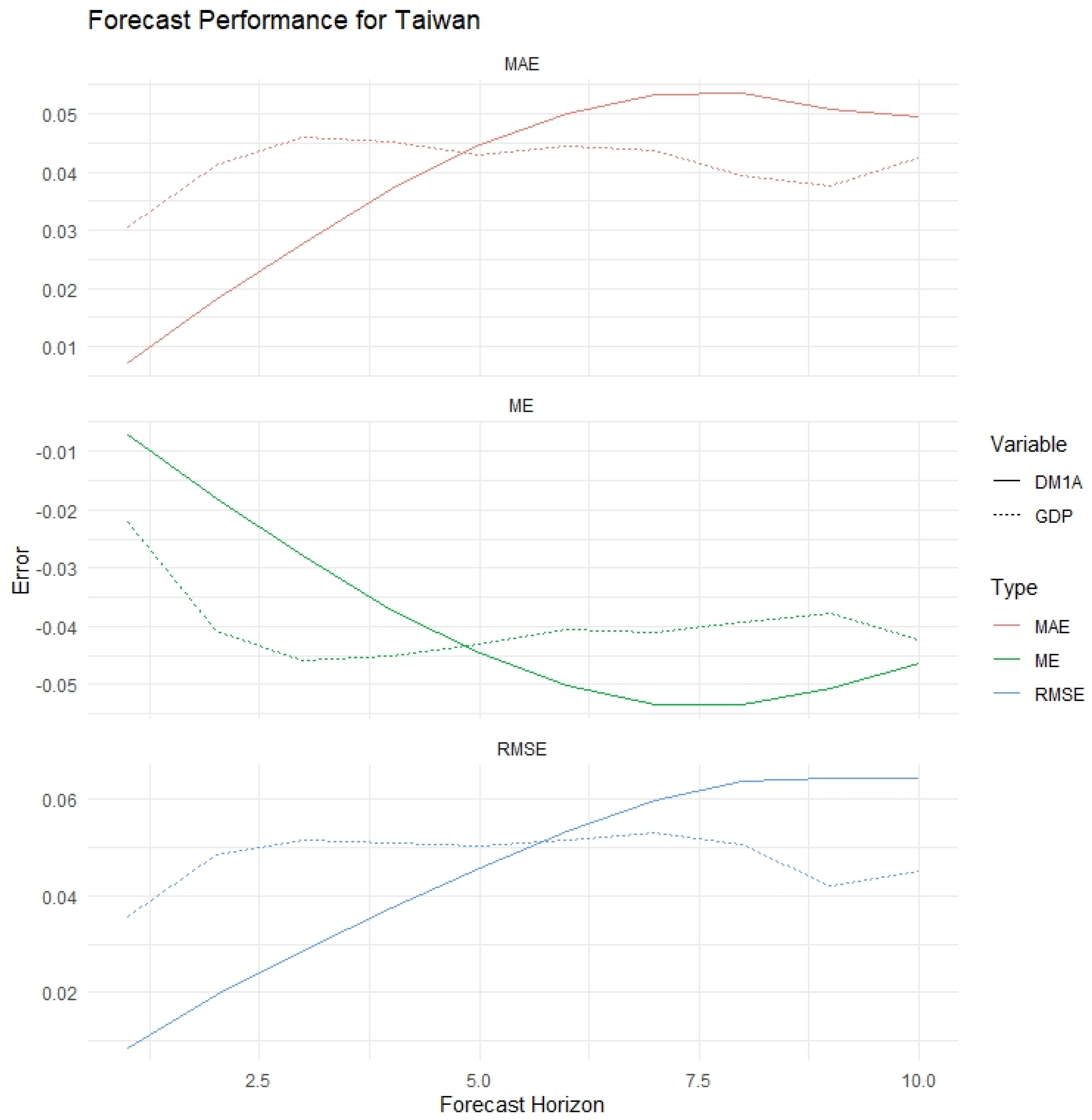
| 1 | The Bank of Korea’s issue note focused on studying M2, precisely matching components with corresponding interest rates. The matching was done as follows: currency (0%), demand deposits (demand deposit rate), short-term time deposits with maturities (pure savings deposits), short-term savings deposits (savings deposit rate), certificates of deposit (certificate of deposit rate), repurchase agreements (repurchase agreement rate), and financial debentures (financial debenture rate). Other items, particularly those not held for transactional purposes, were likely excluded from the analysis, indicating a prioritization of components with clearly defined interest rates. We thank Dr. Park for his kind response to our email inquiry. |
| 2 | We would also like to extend our gratitude to the former Financial Supervisory Service employee who provided helpful insights into the BOK’s data collection process. |
| 3 | Lee (2016) analyzed the 3-year government bond yield as a variable that increased the risk-weighted asset ratio in life insurance companies following the global financial crisis of 2008. This suggests that the 3-year government bond yield influences the interest rate decisions of life insurance companies and can be used as a proxy interest rate. |
References
- Akaike, Htrotugu. 1973. Maximum likelihood identification of Gaussian autoregressive moving average models. Biometrika 60: 255–65. [Google Scholar] [CrossRef]
- Alkhareif, Ryadh, and Moayad Al-Rasasi. 2021. Estimating the money demand function for Saudi Arabia using Divisia monetary aggregate. Applied Economics 53: 4823–34. [Google Scholar] [CrossRef]
- Anderson, Richard G., and Barry E. Jones. 2011. A comprehensive revision of the U.S. monetary services (Divisia) indexes. Federal Reserve Bank of St. Louis Review 93: 325–60. [Google Scholar] [CrossRef][Green Version]
- Barnett, William A. 1978. The user cost of money. Economic Letters 1: 145–49. [Google Scholar] [CrossRef]
- Barnett, William A. 1980. Economics monetary aggregates: An application of index number and aggregation theory. Journal of Econometrics 14: 11–48. [Google Scholar] [CrossRef]
- Barnett, William A. 1981. The new monetary aggregates: A comment. Journal of Money, Credit, and Banking 13: 485–89. [Google Scholar] [CrossRef]
- Barnett, William A. 1982. The optimal level of monetary aggregation. Journal of Money, Credit, and Banking 14: 687–710. [Google Scholar] [CrossRef]
- Barnett, William A. 2010. Monetary aggregation. In Monetary Economics. Edited by Steven N. Durlauf and Lawrence E. Blume. The New Palgrave Economics Collection. London: Palgrave Macmillan. [Google Scholar]
- Barnett, William A. 2016. Friedman and Divisia monetary measures. In Milton Friedman: Contributions to Economics and Public Policy. Edited by Robert A. Cord and J. Daniel Hammond. Oxford: Oxford University Press. [Google Scholar] [CrossRef]
- Barnett, William A., and Neepa Gaekwad. 2021. Multilateral Divisia Monetary Aggregates for the Euro Area. Working Papers Series in Theoretical and Applied Economics 202108. Lawrence: Department of Economics, University of Kansas. [Google Scholar]
- Barnett, William A., and Van H. Nguyen. 2021. Constructing Divisia monetary aggregates for Singapore. Journal of Risk and Financial Management 14: 370. [Google Scholar] [CrossRef]
- Barnett, William A., Douglas Fisher, and Apostolos Serletis. 1992. Consumer theory and the demand for money. Journal of Economic Literature 30: 2086–119. Available online: https://www.jstor.org/stable/2727974 (accessed on 11 February 2023).
- Barnett, William A., Giovanni Bella, Taniya Ghosh, Paolo Mattana, and Beatrice Venturi. 2022a. Is policy causing chaos in the United Kingdom? Economic Modelling 108: 105767. [Google Scholar] [CrossRef]
- Barnett, William A., Jia Liu, Ryan S. Mattson, and van den Jeff Noort. 2013. The new CFS Divisia monetary aggregates: Design, construction, and data sources. Open Economies Review 24: 101–24. [Google Scholar] [CrossRef]
- Barnett, William A., Kun He, and Jingtong He. 2022b. Consumption loan augmented Divisia monetary index and China monetary aggregation. Journal of Risk and Financial Management 15: 447. [Google Scholar] [CrossRef]
- Barnett, William A., Soumya S. Bhadury, and Taniya Ghosh. 2016. A SVAR approach to evaluation of monetary policy in India: Solution to the exchange rate puzzles in an open economy. Open Economies Review 27: 871–93. [Google Scholar] [CrossRef]
- Belongia, Michael T. 1996. Measurement matters: Recent results from monetary economics reexamined. Journal of Political Economy 104: 1065–83. [Google Scholar] [CrossRef]
- Belongia, Michael T., and Peter N. Ireland. 2016. Money and output: Friedman and Schwartz revisited. Journal of Money, Credit and Banking 48: 1223–66. [Google Scholar] [CrossRef]
- Belongia, Michael T., and Peter N. Ireland. 2021. Targeting Nominal Income under the Zero Lower Bound: The Case of the Bank of England. Available online: https://centerforfinancialstability.org/amfm/studies/ukngdp2021.pdf (accessed on 8 August 2024).
- Belongia, Michael T., and Peter N. Ireland. 2022. Strengthening the second pillar: A greater role for money in the ECB’s strategy. Applied Economics 54: 99–114. [Google Scholar] [CrossRef]
- Benchimol, Jonathan. 2016. Money and monetary policy in Israel during the last decade. Journal of Policy Modeling 38: 103–24. [Google Scholar] [CrossRef]
- Berar, R., and Jenny Owladi. 2013. Amendments to Divisia money series. Monetary and Financial Statistics. January 1–2. Available online: https://escoe-website.s3.amazonaws.com/wp-content/uploads/2019/01/30141731/Amendments-to-Divisia-money-series-by-Rajveer-Berar-and-Jenny-Owladi.pdf (accessed on 8 August 2024).
- Bhatnagar, Aryaman. 2022. Divisia Aggregates and Monetary Policy in India. unpublished paper. [Google Scholar]
- Binner, Jane M., Alicia M. Gazely, and Shu H. Chen. 2002. Financial innovation and Divisia monetary indices in Taiwan: A neural network approach. The European Journal of Finance 8: 238–47. [Google Scholar] [CrossRef]
- Binner, Jane M., and Logan J. Kelly. 2017. Modelling money shocks in a small open economy: The case of Taiwan. The Manchester School 85: 104–20. [Google Scholar] [CrossRef]
- Bissoondeeal, Rakesh K., Barry E. Jones, Jane M. Binner, and Andrew W. Mullineux. 2010. Household-sector money demand for the UK. The Manchester School 78: 90–113. [Google Scholar] [CrossRef]
- Boughton, James H. 1981. Money and its substitutes. Journal of Monetary Economics 8: 375–86. [Google Scholar] [CrossRef]
- Brill, Maximilian C., Dieter Nautz, and Lea Sieckmann. 2021. Divisia monetary aggregates for a heterogeneous euro area. Empirica 48: 247–78. [Google Scholar] [CrossRef]
- Chen, Wenjuan, and Dieter Nautz. 2015. The Information Content of Monetary Statistics for the Great Recession: Evidence from Germany (No. 2015-027). SFB 649 Discussion Paper. Available online: https://www.econstor.eu/bitstream/10419/119434/1/826639127.pdf (accessed on 8 August 2024).
- Chetty, V. Karuppan. 1969. On measuring the nearness of near-moneys. American Economic Review 59: 270–81. Available online: http://www.jstor.org/stable/1808957 (accessed on 11 February 2023).
- Chrystal, Alec K., and Ronald MacDonald. 1994. Empirical evidence on the recent behavior and usefulness of simple-sum and weighted measures of the money stock. Federal Reserve Bank of St. Louis Review 76: 73–109. [Google Scholar] [CrossRef]
- Darvas, Zsolt. 2015. Does money matter in the euro area? Evidence from a new Divisia index. Economics Letters 133: 123–26. [Google Scholar] [CrossRef]
- Diewert, Erwin W. 1976. Exact and superlative index numbers. Journal of Econometrics 4: 115–45. [Google Scholar] [CrossRef]
- El-Shagi, Makram, and Logan J. Kelly. 2013. Liquidity in the Liquidity Crisis: Evidence from Divisia Monetary Aggregates in Germany and the European Crisis Countries. Economics Bulletin 34: 63–72. Available online: http://www.accessecon.com/Pubs/EB/2014/Volume34/EB-14-V34-I1-P7.pdf (accessed on 6 August 2024).
- Engle, Robert F., and Clive W. J. Granger. 1987. Co-integration and error correction: Representation, estimation, and testing. Econometrica 55: 251–76. [Google Scholar] [CrossRef]
- Feige, Edgar, and Douglas Pearce. 1977. The substitutability of money and near-monies: A survey of the time-series evidence. Journal of Economic Literature 15: 439–69. Available online: https://www.jstor.org/stable/2723210 (accessed on 11 February 2023).
- Fisher, Irving. 1922. The Making of Index Numbers: A Study of Their Varieties, Tests, and Reliability. Boston and New York: Houghton Mifflin Company. [Google Scholar]
- Fleissig, Adrian R., Barry E. Jones, and Zsolt Darvas. 2023. Euro area monetary asset demand and Divisia aggregates. The European Journal of Finance 29: 1885–912. [Google Scholar] [CrossRef]
- Friedman, Milton, and Anna J. Schwartz. 1963. A Monetary History of the United States, 1867–1960. Princeton: Princeton University Press. Available online: http://www.jstor.org/stable/j.ctt7s1vp (accessed on 23 September 2024).
- Ghosh, Taniya, and Soumya Bhadury. 2018. Money’s causal role in exchange rates: Do Divisia monetary aggregates explain more? International Review of Economics & Finance 57: 402–17. [Google Scholar] [CrossRef]
- Gogas, Periklis, Theophilos Papadimitriou, and Emmanouil Sofianos. 2019. Money neutrality, monetary aggregates and machine learning. Algorithms 12: 137. [Google Scholar] [CrossRef]
- Habibullah, Muzafar S. 1999. Divisia Monetary Aggregates and Economic Activities in Asian Developing Economies, 1st ed. London: Routledge. [Google Scholar] [CrossRef]
- Hahm, Jeong Ho, and Jun Tae Kim. 2000. The signals from Divisia money in a rapidly growing economy. In Divisia Monetary Aggregates. Edited by Michael T. Belongia and Jane M. Binner. London: Palgrave Macmillan. [Google Scholar] [CrossRef]
- Hendrickson, Joshua R. 2014. Redundancy or mismeasurement? A reappraisal of money. Macroeconomic Dynamics 18: 1437–65. [Google Scholar] [CrossRef]
- International Monetary Fund. 2000. Monetary and Financial Statistics Manual. Washington, DC: International Monetary Fund. [Google Scholar]
- Ishida, Kazuhiko. 1984. Divisia monetary aggregates and the demand for money: A Japanese case. Bank of Japan Monetary and Economic Studies 2: 49–80. Available online: https://www.imes.boj.or.jp/research/papers/english/me2-1-2.pdf (accessed on 7 August 2024).
- Jha, Raghbendra, and Ibotombi S. Longjam. 2008. A Divisia type saving aggregate for India. Macroeconomics and Finance in Emerging Market Economies 1: 51–66. [Google Scholar] [CrossRef][Green Version]
- Johansen, Søren. 1988. Statistical analysis of cointegration vectors. Journal of Economic Dynamics and Control 12: 231–54. [Google Scholar] [CrossRef]
- Johansen, Søren, and Katarina Juselius. 1990. Maximum likelihood estimation and inference on cointegration—With applications to the demand for money. Oxford Bulletin of Economics and Statistics 52: 169–210. [Google Scholar] [CrossRef]
- Keating, John W., Logan J. Kelly, and Valcarcel J. Valcarcel. 2014. Solving the price puzzle with an alternative indicator of monetary policy. Economics Letters 124: 188–94. [Google Scholar] [CrossRef]
- Kelly, Logan J., Jane M. Binner, and Jonathan Tepper. 2024. Do monetary aggregates improve inflation forecasting in Switzerland? Journal of Management Policy and Practice 25: 124–33. [Google Scholar] [CrossRef]
- Korea Institute of Finance. 2016. Discussion on the utility of Divisia monetary aggregates. Weekly Financial Brief 25: 16–17. (In Korean). [Google Scholar]
- Kumah, Emmanuel O. 1989. Monetary Concept and Definitions. IMF Working Paper, 89/92. Available online: https://ssrn.com/abstract=885054 (accessed on 7 June 2024).
- Lee, Seok Ho. 2016. A comparative analysis of managerial performance between financial capital-affiliated and industrial capital-affiliated insurance companies. In KIF Financial Analysis Report 2016-02. Seoul: Korea Institute of Finance. (In Korean) [Google Scholar]
- Leong, Choi-Meng, Chin-Hong Puah, Evan Lau, and Abu M. Shazali. 2019. Asymmetric effects of exchange rate changes on the demand for divisia money in Malaysia. Journal of International Studies 12: 52–62. [Google Scholar] [CrossRef]
- Michelson, Noam, and Tanya Suhoy. 2014. Weekly monitoring of financial systems in transition: A financial conditions index and a credit conditions index-the Israeli case. Paper presented at World Finance Conference, Venice, Italy, July 2–4. [Google Scholar]
- Moroney, John R., and Barry J. Wilbratte. 1976. Money and money substitutes: A time series analysis of household portfolios. Journal of Money, Credit and Banking 8: 181–98. [Google Scholar] [CrossRef]
- Park, Kyung Hoon, and Yeon Jeong Shim. 2018. Analysis of the relationship between money supply and economic conditions. In Issue Note 2018-1. Seoul: Bank of Korea. (In Korean) [Google Scholar]
- Polat, Umurcan. 2018. Divisia and simple sum monetary aggregates: Any empirical relevance for Turkey? Journal of Central Banking Theory and Practice 7: 175–206. [Google Scholar] [CrossRef]
- Puah, Chin-Hong, and Lee-Chea Hiew. 2011. Financial liberalization weighted monetary aggregates and money demand in Indonesia. Labuan Bulletin of International Business and Finance (LBIBF) 8: 76–93. [Google Scholar] [CrossRef]
- Ramachandran, M., Rajib Das, and Binod B. Bhoi. 2010. The Divisia monetary indices as leading indicators of inflation. Indian Economic Journal 58: 3–30. [Google Scholar] [CrossRef]
- Restrepo-Tobón, Diego A. 2015. Evidence that risk adjustment is unnecessary in estimates of the user cost of money. Ecos de Economía 19: 49–70. [Google Scholar] [CrossRef]
- Sarwar, Haroon, Zakir Hussain, and M. Sarwar Awan. 2010. Money demand function for Pakistan (Divisia approach). Pakistan Economic and Social Review 48: 1–20. Available online: http://www.jstor.org/stable/41762411 (accessed on 8 August 2024).
- Sengupta, Anirban, Apostolos Serletis, and Libo Xu. 2024. Divisia monetary aggregates for India. Studies in Nonlinear Dynamics & Econometrics. [Google Scholar] [CrossRef]
- Serletis, Apostolos, and Periklis Gogas. 2014. Divisia monetary aggregates, the great ratios, and classical money demand functions. Journal of Money, Credit and Banking 46: 229–41. Available online: http://www.jstor.org/stable/42920078 (accessed on 7 August 2024). [CrossRef]
- Shih, Yen C. 2000. Divisia monetary aggregates for Taiwan. In Divisia Monetary Aggregates. Edited by Michael T. Belongia and Jane M. Binner. London: Palgrave Macmillan. [Google Scholar] [CrossRef]
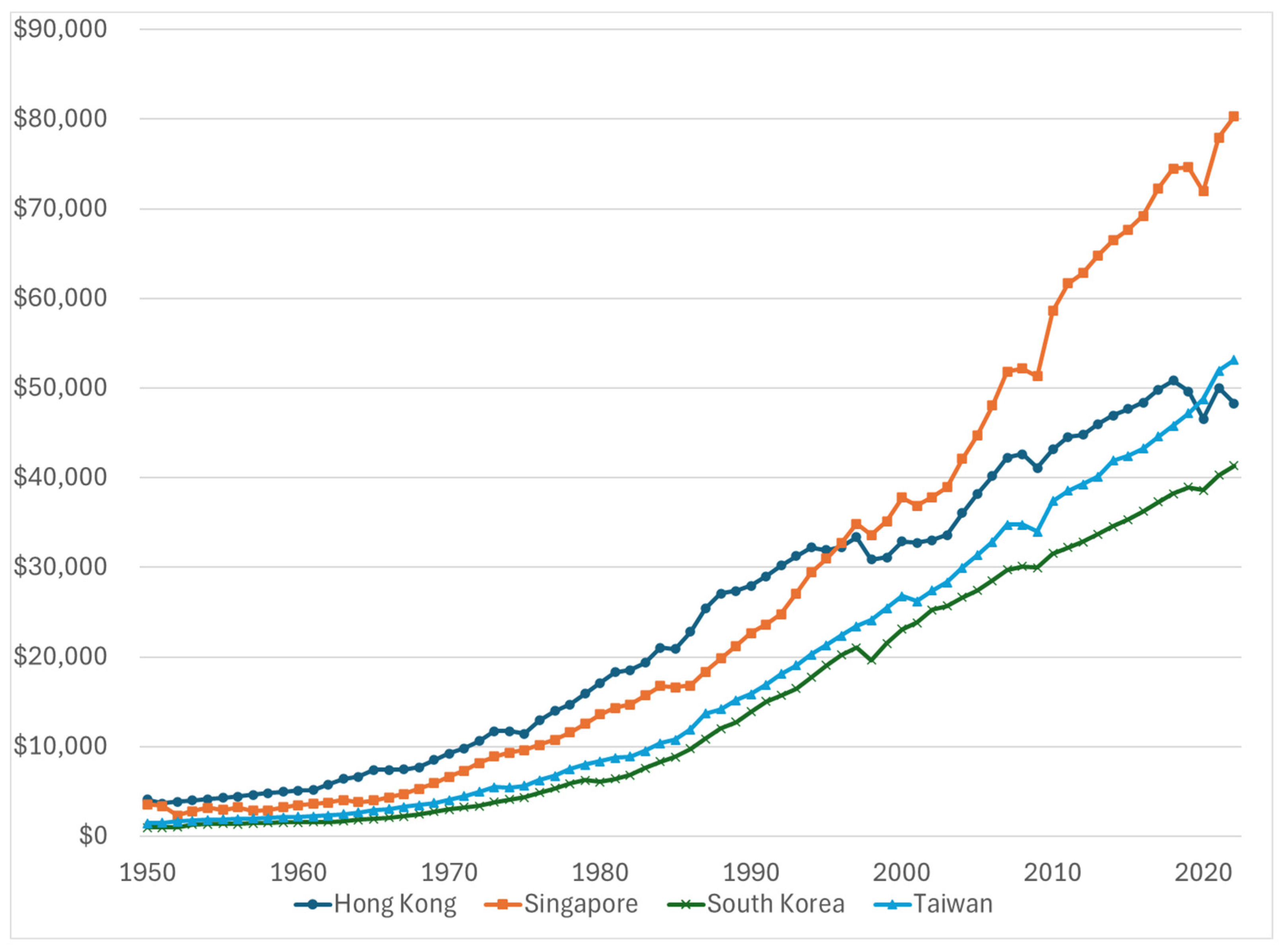
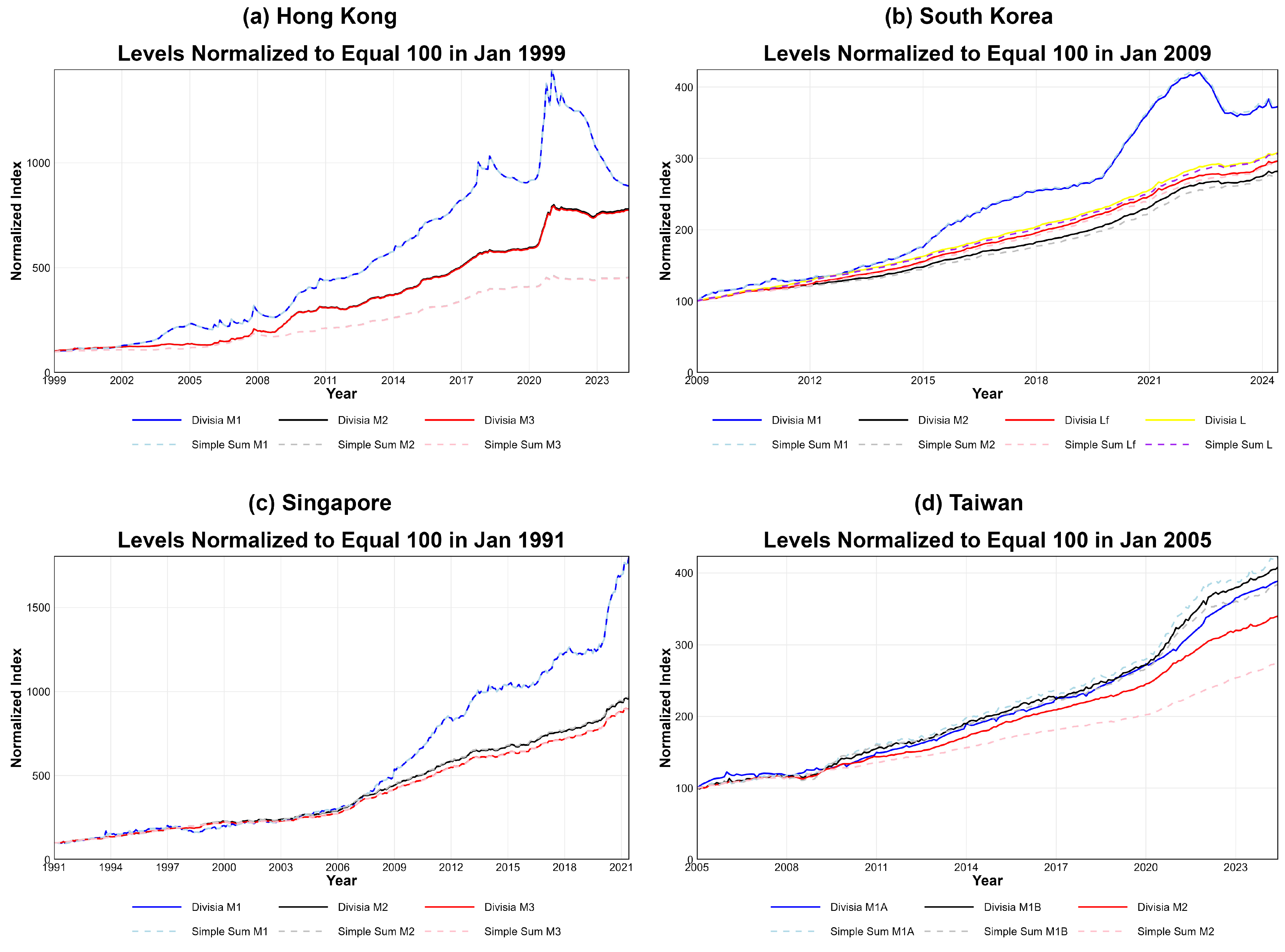
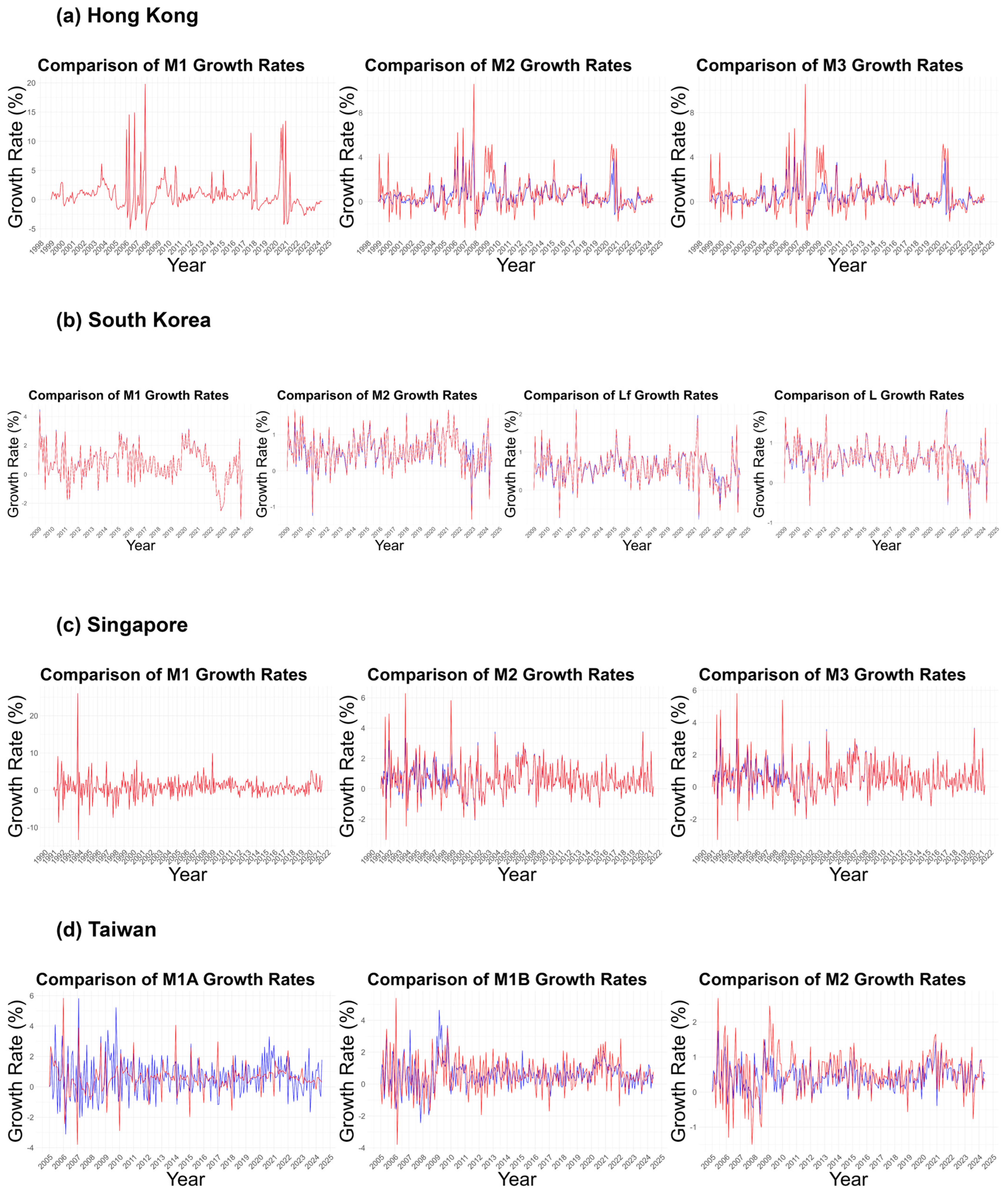
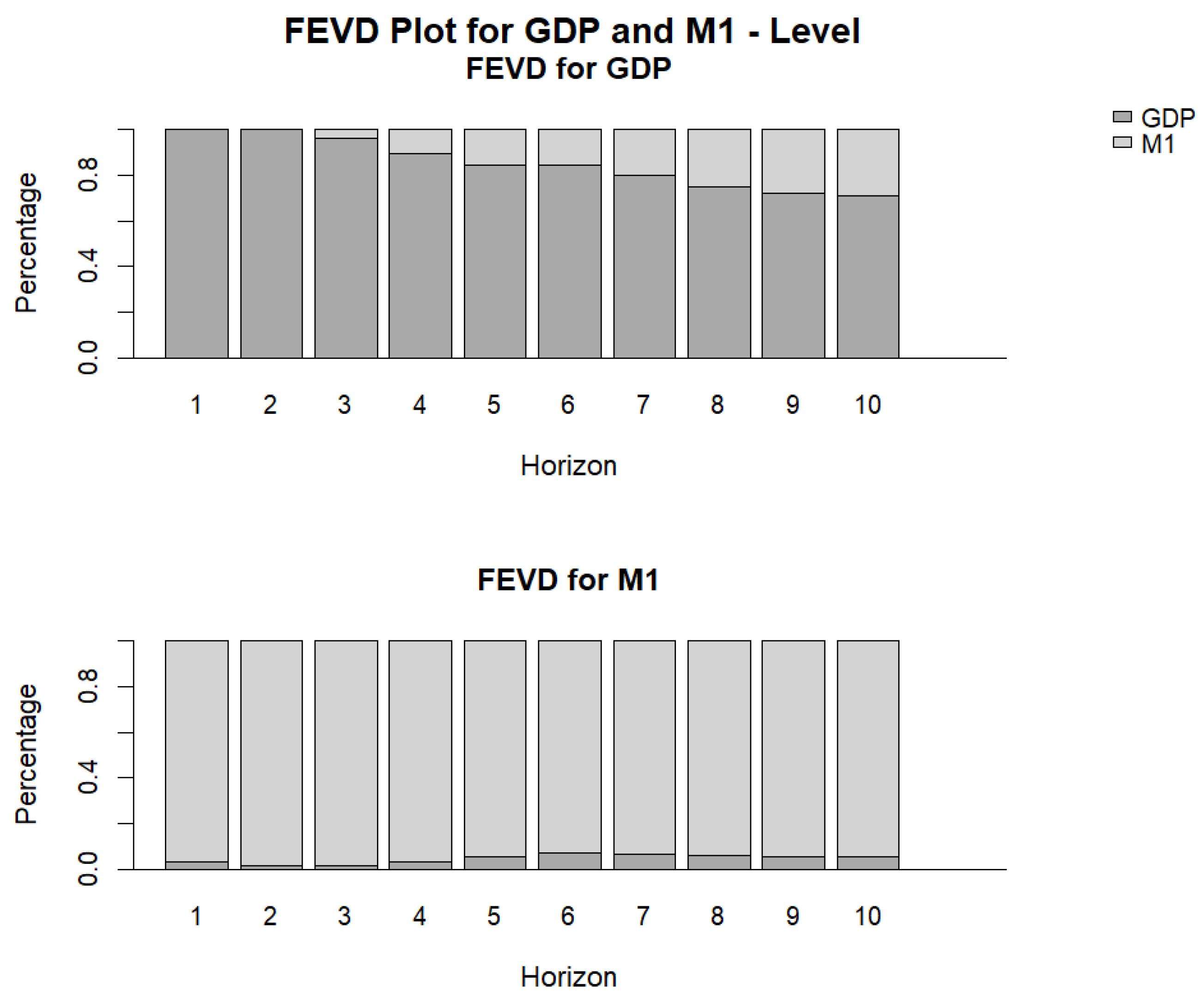

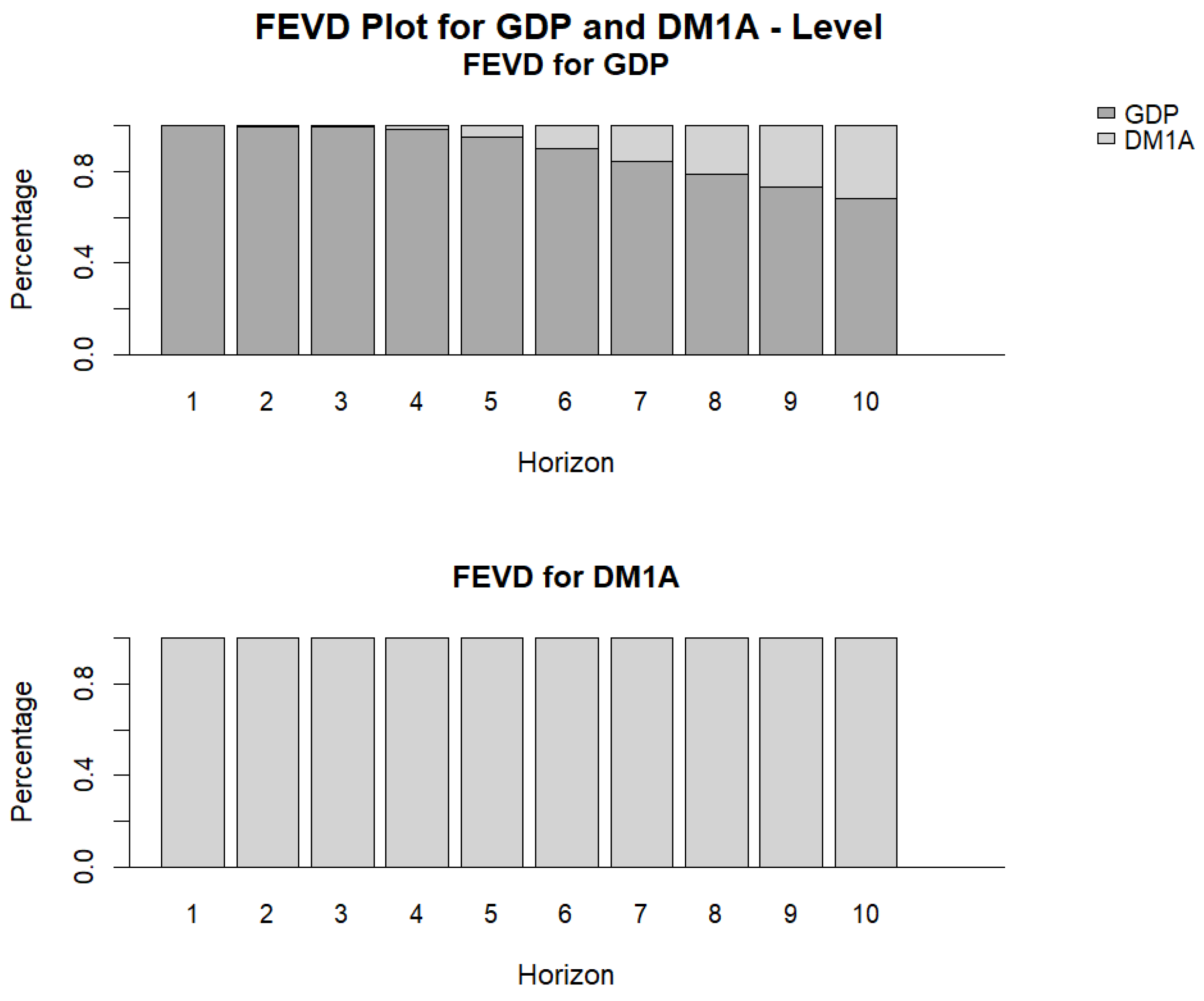
| Variables | ECT in Output Equation | ECT in Money Equation |
|---|---|---|
| M1 | Significant | Not significant |
| DM1 | Significant | Not significant |
| M2 1 | -- | -- |
| DM2 1 | -- | -- |
| M3 1 | -- | -- |
| DM3 1 | -- | -- |
| R 1 | -- | -- |
| NGDP and M1 | ||
| Eigenvectors, normalized to the first column: | ||
| Variables | NGDP | |
| NGDP | 1.000 | 1.000 |
| M1 | −0.398 *** | −0.134 |
| Loading matrix | ||
| Variables | NGDP | |
| ΔNGDP | −0.231 *** | −0.00314 *** |
| ΔM1 | −0.0262 | −0.0505 |
| NGDP and DM1 | ||
| Eigenvectors, normalized to the first column: | ||
| Variables | NGDP | |
| NGDP | 1.000 | 1.000 |
| DM1 | −0.398 *** | −0.134 |
| Loading matrix | ||
| Variables | NGDP | |
| ΔNGDP | −0.231 *** | −0.00314 *** |
| ΔDM1 | −0.0262 | −0.0505 |
| Variables | ECT in Output Equation | ECT in Money Equation |
|---|---|---|
| M1A 1 | -- | -- |
| DM1A | Significant | Not significant |
| M1B 1 | -- | -- |
| DM1B 1 | -- | -- |
| M2 1 | -- | -- |
| DM2 1 | -- | -- |
| R 1 | -- | -- |
| NGDP and DM1A | ||
| Eigenvectors, normalized to the first column: | ||
| Variables | NGDP | A |
| NGDP | 1.000 | 1.000 |
| DM1A | −0.554 *** | −0.320 |
| Loading matrix | ||
| Variables | NGDP | A |
| ΔNGDP | −0.386 *** | −0.00420 *** |
| ΔDM1A | −0.0117 | 0.0170 |
Disclaimer/Publisher’s Note: The statements, opinions and data contained in all publications are solely those of the individual author(s) and contributor(s) and not of MDPI and/or the editor(s). MDPI and/or the editor(s) disclaim responsibility for any injury to people or property resulting from any ideas, methods, instructions or products referred to in the content. |
© 2024 by the authors. Licensee MDPI, Basel, Switzerland. This article is an open access article distributed under the terms and conditions of the Creative Commons Attribution (CC BY) license (https://creativecommons.org/licenses/by/4.0/).
Share and Cite
Barnett, W.A.; Lee, J.; Mohiuddin, N. Constructing Divisia Monetary Aggregates for the Asian Tigers. J. Risk Financial Manag. 2024, 17, 435. https://doi.org/10.3390/jrfm17100435
Barnett WA, Lee J, Mohiuddin N. Constructing Divisia Monetary Aggregates for the Asian Tigers. Journal of Risk and Financial Management. 2024; 17(10):435. https://doi.org/10.3390/jrfm17100435
Chicago/Turabian StyleBarnett, William A., JongSoo Lee, and Naowar Mohiuddin. 2024. "Constructing Divisia Monetary Aggregates for the Asian Tigers" Journal of Risk and Financial Management 17, no. 10: 435. https://doi.org/10.3390/jrfm17100435
APA StyleBarnett, W. A., Lee, J., & Mohiuddin, N. (2024). Constructing Divisia Monetary Aggregates for the Asian Tigers. Journal of Risk and Financial Management, 17(10), 435. https://doi.org/10.3390/jrfm17100435








